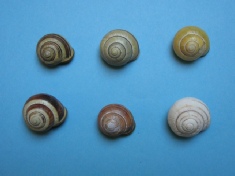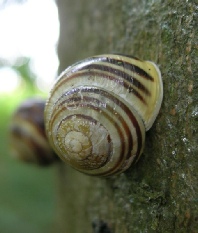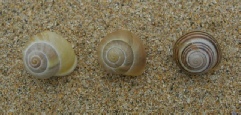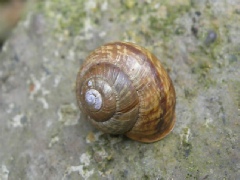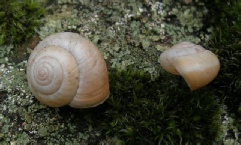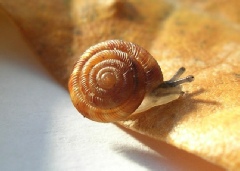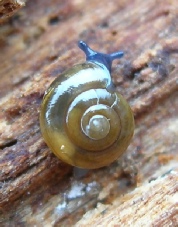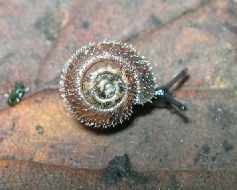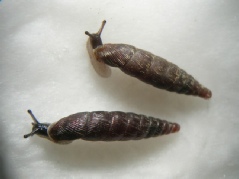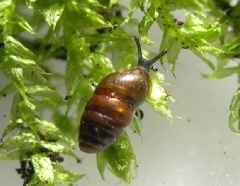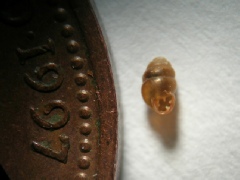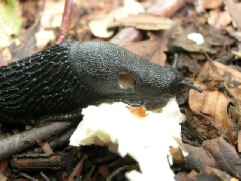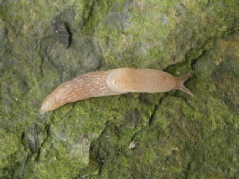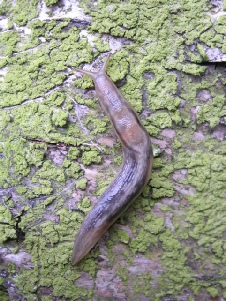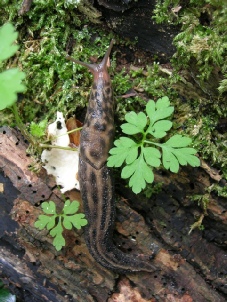
Dave Barlow © Cleveland Naturalists’ Field Club. 7th April 2024



Welcome to Cleveland Naturalists’ Field Club
|
|
|
|
|
Fig. 1 Common Garden Snail (Cornu aspersum formerly Helix aspersa) Our largest snail; adult shell width up to about 35mm. The shell has a characteristic wrinkled surface. There are no similar species. |
Fig. 2 Common Garden Snail Seen from below crawling on a pane of glass. The light and dark bands on the sole are muscular ripples which move forwards as the snail crawls. |
Fig . 3 Brown-lipped Snail (Cepaea nemoralis) Adult shell width up to about 25mm. Widespread and common in a variety of habitats. Variable in appearance but typically yellow with up to five dark spiral bands. Shell lip (which develops when the animal is fully grown) is nearly always brown (rarely white). |
|
Fig. 4 Brown-lipped Snail Background colour may be yellow, pink, orange or brown. Some or all of the bands may be faint or absent. The bottom right hand individual was found amid sand dunes, the coloured outer layer of the shell having been lost by abrasion. |
Fig. 5 White-lipped Snail (Cepaea hortensis) On average a little smaller than C. nemoralis, adult shell width about 20mm, but both species are quite variable in size and there is much overlap. Lip nearly always white (rarely brown) but otherwise shell colour variable. In Cleveland this species can be found in vegetation along river banks and in coastal grassland |
Fig. 6 White-lipped Snail Two bands are missing from the shell of this animal and the remaining three are faint. The transverse ridge represents an interruption to growth. This would be during winter when the animal hibernated before completing its growth during the following spring. |
|
Fig. 7 White-lipped Snail As with C. nemoralis the shell is very variable in appearance, the background colour is sometimes a pale buff-brown. |
Fig. 8 Copse Snail (Arianta arbustorum) Adult shell width about 25mm. Typically a species of moist sites in woodland. Overall shade of both shell and body can vary but normally there is a red-brown spiral band around the periphery of the shell which has a flecked pattern rather than being evenly coloured. |
Fig. 9 Kentish Snail (Monacha cantiana) This is the fifth large and conspicuous snail to occur in this area; adult shell width about 20mm. It is near to the northern edge of its range and rather locally distributed in the Cleveland area, often in disturbed habitats. The shell is typically pinkish-buff with a whitish peripheral spiral band. |
|
Fig.10 Rounded Snail (Discus rotundatus) Being smaller than the previously described species this snail has to be looked for rather than be encountered; adult shell width up to about 7mm, proportionately wide and flattened. It is very widespread and common in a wide range of moderately moist habitats including gardens, found beneath timber and stones and in leaf litter. The regularly ridged shell, usually with alternating pale and reddish bands, is distinctive. |
Fig. 11 Garlic Snail (Oxychilus alliarius) Adult shell width up to about 7mm. Occurs in a similar wide range of habitats to D. rotundatus. This is the most common of a number of smaller snail species having shiny, flat, brownish shells but this one normally smells quite strongly of garlic when the body surface is irritated gently. |
Fig.12 Strawberry Snail (Trochulus striolatus formerly Trichia striolata) Adult shell width up to about 14mm. Adult size, flattened profile and a pale peripheral band serve to distinguish this species. Shell pale to dark brown and rather translucent, sometimes with blotches of dark body pigment showing through. Widespread and common in Cleveland, this snail often ascends vegetation in damp weather, including tree trunks as in this image. |
|
Fig. 13 Hairy Snail (Trochulus hispidus formerly Trichia hispida) Adult shell width about 10mm (variable). Fresh shells from moist habitats have a coating of curved hairs but these can be worn away from the shells of snails living in drier places. A less common species (the Silky Snail Ashfordia granulata, which has straight hairs, occurs in moist sites in some of the older Cleveland woodlands. |
Fig. 14 Two-toothed Door Snail (Clausilia bidentata) Adult shell height up to about 12mm. So named because there are tooth-like structures around the shell mouth (as in a number of other snail species, see e.g. Fig. 16) and a leathery trap door that serve to keep out predators when the animal withdraws into its shell. Most often occurring in older woodlands in Cleveland, this snail can often be found crawling on tree trunks. |
Fig. 15 Common Chrysalis Snail (Lauria cylindracea) Adult height about 4mm but height in proportion to width can vary a good deal, some individuals being shorter than the one illustrated. This is a common and widespread small species of both open and wooded habitats, found in leaf litter, under timber and rocks, on dry-stone walls and in similar habitats. |
|
Fig. 16 Common Whorl Snail (Vertigo pygmaea) Adult shell height 2mm, photographed beside a penny to give an idea of scale. It is included here as representative of numerous snail species that are little or no bigger than this. In spite of its name this species is not particularly common in Cleveland. |
Fig. 17 Great Black Slug (Arion ater aggregate) Extended length up to about 150mm, this is the large slug that occurs seemingly everywhere. It can be varying shades of brown, grey-green and orange where it occurs close to human habitation, more usually black in wilder places. This individual was in the process of devouring a toadstool. The breathing pore (pneumostome) is clearly visible as is the roughened texture of the mantle (the area of the back behind the head). This pattern is characteristic of members of the family Arionidae, the Great Black Slug having several much smaller dark coloured relatives, some of which are very common. |
Fig. 18 Netted Slug (Deroceras reticulatum) Extended length up to about 50mm. This is a very common species which produces milky white slime when irritated. Some individuals can be much darker than the one shown, almost black. In this family (the Limacidae) the mantle has a pattern of concentric ridges (see also Figs. 19-21). |
|
Fig. 19 Tree Slug (Lehmannia marginata formerly Limax marginatus) Extended length up to about 70mm. Often found climbing on tree trunks or on dry-stone walls, this slug is quite translucent, especially when lit from behind. When irritated it produces large amounts of watery, colourless slime. |
Fig. 20 Great Grey Slug (Limax maximus) Extended length up to about 150mm. A striking and fairly common species found in a variety of habitats, often under larger pieces of timber. A combination of spots on the mantle and lateral stripes is characteristic. |
Fig. 21 Great Grey Slug A darker individual; this is the more frequently encountered form in Cleveland. |
Snails and Slugs
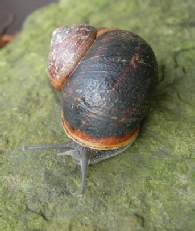


The best guide to British snails and slugs is still A Field Guide to the land Snails of Britain and North-west Europe, M. P. Kerney & R. A. D. Cameron, Collins 1979.
(The original edition has a much better quality version of the numerous line drawings than does the later re-print).
Links:
Website of the Conchological Society of Britain and Ireland: www.conchsoc.org
This site has a comprehensive range of high quality images: www.habitas.org.uk/molluscireland/
